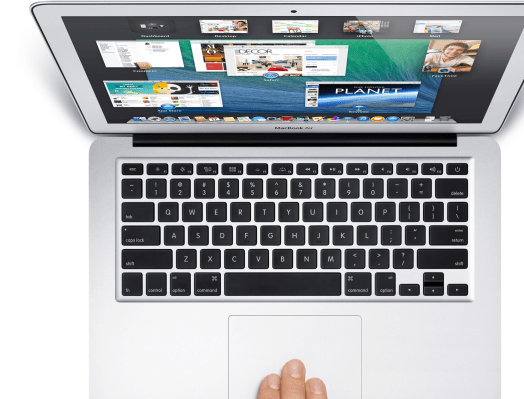Apple has indeed updated its MacBook Air as foretold, and while the updates aren’t terribly dramatic, they are solid improvements that should come as welcome news to anyone who has been waiting in the wings for a reason to upgrade. The new models now start at $899 for the 11-inch model, and $999 for the 13-inch model. Now is definitely the time for Apple to be capitalizing on their strong Mac market position, coming out of a solid fiscal Q2 when it sold 4.1 million Macs, an improvement on the 3.9 million units it shipped during the same quarter last year.
Apple’s new MacBook Airs gain processor improvements, using new Intel Haswell chips that push power up a notch, which should make for even faster, more efficient operation over the models introduced last year at WWDC in June. Storage options also get tweaked, with better baseline options. Everything from the base model to the top end gets improved processors, so regardless of your budget or needs you’ll be getting more for your money.
Evolutionary improvements in the Mac are designed to do one thing: Keep sales of Apple’s desktops and notebooks chugging along. And they have indeed built up a considerable head of steam, which is impressive in a market where consumers are starting to show a lot of skepticism about whether they even need or want traditional computing devices. Mac sales were up 5 percent last quarter when compared year over year, while the rest of the PC industry actually fell about the same amount over the same period (roughly 4 percent), as measured by IDC. Macs are the only category of computer to have gained share in the PC industry for 31 out of the past 32 quarters, too (that’s eight years, in case you need help with the math).
The MacBook Air has arguably become Apple’s flagship Mac in recent years, after a debut as somewhat of an oddity and outlier device. When Apple introduces its significantly redesigned MacBook Air in 2010, introducing an 11.6-inch model alongside the 13.3-inch version, that changed and the device became a strong seller. Eventually, the price point for the entry-level models fell below $1,000, and it became the defacto replacement for the basic MacBook. Which means the ultraportable was no longer exotic, but was instead the natural option for most users.
Also worth noting: Apple’s big WWDC conference is coming in June, and while it might not make any earth-shattering hardware announcements at that event, it will likely reveal the next generation of OS X. OS X 10.9 Mavericks brought improvements designed for the just-updated MacBook Air then ahead of its actual consumer launch, so I’d bet this new hardware is probably designed with the next generation of OS X in mind, too.
